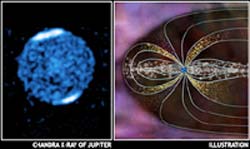Chandra probes high-voltage auroras on Jupiter

Jupiter shows intense X-ray emission associated with auroras in its polar regions (Chandra image on left). Extended monitoring by Chandra showed that the auroral X-rays are caused by highly charged particles crashing into the atmosphere above Jupiter’s poles. The charged particles were primarily ions of oxygen and other elements that were stripped of most of their electrons, which implies that the ions were accelerated to high energies in a multimillion-volt environment above the planet’s poles. Such high voltages indicate that the cause of many of Jupiter’s auroras is different from auroras produced on Earth or Saturn. The accompanying schematic illustrates how Jupiter’s unusually frequent and spectacular auroral activity is produced. Jupiter’s strong, rapidly rotating magnetic field (light blue lines) generates strong electric fields in the space around the planet. Particles (white dots) from Jupiter’s volcanically active moon, Io, drift outward to create a huge reservoir of electrons and ions. These charged particles, trapped in Jupiter’s magnetic field, are continually being accelerated (gold particles) down into the atmosphere above the polar regions, so auroras are almost always active on Jupiter. Electric voltages of about 10 million volts, and currents of 10 million amps - a hundred times greater than the most powerful lightning bolts - are required to explain the auroras, which are a thousand times more powerful than those on Earth. On Earth, auroras are triggered by solar storms of energetic particles, which disturb Earth’s magnetic field. As shown by the swept-back appearance in the illustration, gusts of particles from the Sun also distort Jupiter’s magnetic field, and on occasion produce auroras. Credit: NASA/CXC/MSFC/R. Elsner et al.
Scientists have obtained new insight into the unique power source for many of Jupiter’s auroras, the most spectacular and active auroras in the Solar System. Extended monitoring of the giant planet with NASA’s Chandra X-ray Observatory detected the presence of highly charged particles crashing into the atmosphere above its poles.
X-ray spectra measured by Chandra showed that the auroral activity was produced by ions of oxygen and other elements that were stripped of most of their electrons. This implies that these particles were accelerated to high energies in a multimillion-volt environment above the planet’s poles. The presence of these energetic ions indicates that the cause of many of Jupiter’s auroras is different from auroras produced on Earth or Saturn.
“Spacecraft have not explored the region above the poles of Jupiter, so X-ray observations provide one of the few ways to probe that environment,” said Ron Elsner of the NASA Marshall Space Center in Huntsville, Alabama, and lead author on a recently published paper describing these results in the Journal for Geophysical Research. “These results will help scientists to understand the mechanism for the power output from Jupiter’s auroras, which are a thousand times more powerful than those on Earth.”
Electric voltages of about 10 million volts, and currents of 10 million amps Ð a hundred times greater than the most powerful lightning bolts Ð are required to explain the X-ray observations. These voltages would also explain the radio emission from energetic electrons observed near Jupiter by the Ulysses spacecraft.
On Earth, auroras are triggered by solar storms of energetic particles, which disturb Earth’s magnetic field. Gusts of particles from the Sun can also produce auroras on Jupiter, but unlike Earth, Jupiter has another way of producing auroras. Jupiter’s rapid rotation, intense magnetic field, and an abundant source of particles from its volcanically active moon, Io, create a huge reservoir of electrons and ions. These charged particles, trapped in Jupiter’s magnetic field, are continually accelerated down into the atmosphere above the polar regions where they collide with gases to produce the aurora, which are almost always active on Jupiter.
If the particles responsible for the aurora came from the Sun, they should have been accompanied by large number of protons, which would have produced an intense ultraviolet aurora. Hubble ultraviolet observations made during the Chandra monitoring period showed relatively weak ultraviolet flaring. The combined Chandra and Hubble data indicate that this auroral activity was caused by the acceleration of charged ions of oxygen and other elements trapped in the polar magnetic field high above Jupiter’s atmosphere.
Chandra observed Jupiter in February 2003 for four rotations of the planet (approximately 40 hours) during intense auroral activity. These Chandra observations, taken with its Advanced CCD Imaging Spectrometer, were accompanied by one-and-a-half hours of Hubble Space Telescope observations at ultraviolet wavelengths.
Media Contact
More Information:
http://www.cfa.harvard.eduAll latest news from the category: Physics and Astronomy
This area deals with the fundamental laws and building blocks of nature and how they interact, the properties and the behavior of matter, and research into space and time and their structures.
innovations-report provides in-depth reports and articles on subjects such as astrophysics, laser technologies, nuclear, quantum, particle and solid-state physics, nanotechnologies, planetary research and findings (Mars, Venus) and developments related to the Hubble Telescope.
Newest articles

Pinpointing hydrogen isotopes in titanium hydride nanofilms
Although it is the smallest and lightest atom, hydrogen can have a big impact by infiltrating other materials and affecting their properties, such as superconductivity and metal-insulator-transitions. Now, researchers from…

A new way of entangling light and sound
For a wide variety of emerging quantum technologies, such as secure quantum communications and quantum computing, quantum entanglement is a prerequisite. Scientists at the Max-Planck-Institute for the Science of Light…

Telescope for NASA’s Roman Mission complete, delivered to Goddard
NASA’s Nancy Grace Roman Space Telescope is one giant step closer to unlocking the mysteries of the universe. The mission has now received its final major delivery: the Optical Telescope…



